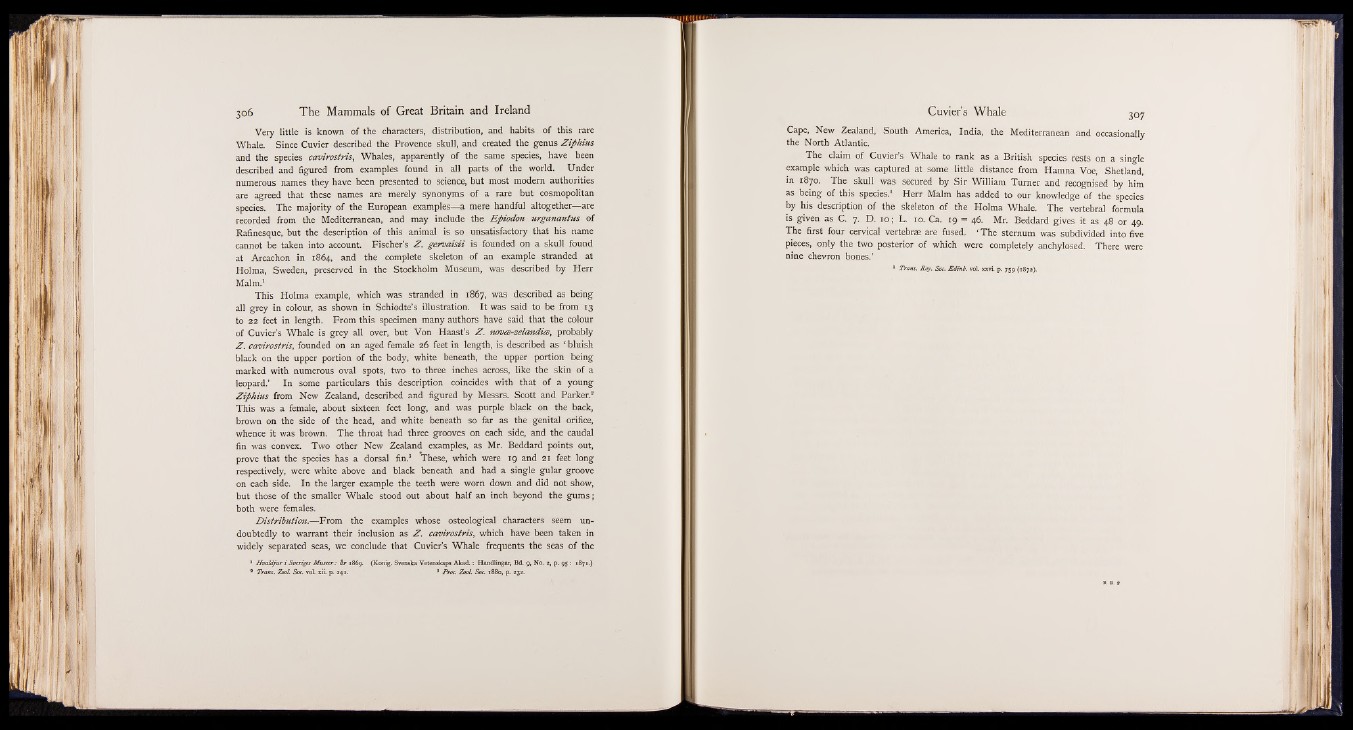
Very little is known of the characters, distribution, and habits of this rare
Whale. Since Cuvier described the Provence skull, and created the genus Ziphius
and the species cavirostris, Whales, apparently of the same species, have been
described and figured from examples found in all parts of the world. Under
numerous names they have been presented to science, but most modern authorities
are agreed that these names are merely synonyms of a rare but cosmopolitan
species. The majority of the European examples— a mere handful altogether— are
recorded from the Mediterranean, and may include the Epiodon urganantus of
Rafinesque, but the description of this animal is so unsatisfactory that his name
cannot be taken into account. Fischer’s Z . gervaisii is founded on a skull found
at Arcachon in 1864, and the complete skeleton of an example stranded at
Holma, Sweden, preserved in the Stockholm Museum, was described by Herr
Malm.1
This Holma example, which was stranded in 1867, was described as being
all grey in colour, as shown in Schiodte’s illustration. It was said to be from 13
to 22 feet in length. From this specimen many authors have said that the colour
of Cuvier’s Whale is grey all over, but Von Haast’s Z . novce-zelandice, probably
Z . cavirostris, founded on an aged female 26 feet in length, is described as ‘ bluish
black on the upper portion of the body, white beneath, the upper portion being
marked with numerous oval spots, two to three inches across, like the skin of a
leopard.’ In some particulars this description coincides with that of a young
Ziphius from New Zealand, described and figured by Messrs. Scott and Parker.2
This was a female, about sixteen feet long, and was purple black on the back,
brown on the side of the head, and white beneath so far as the genital orifice,
whence it was brown. The throat had three grooves on each side, and the caudal
fin was convex. Two other New Zealand examples, as Mr. Beddard points out,
prove that the species has a dorsal fin.8 These, which were 19 and 21 feet long
respectively, were white above and black beneath and had a single gular groove
on each side. In the larger example the teeth were worn down and did not show,
but those of the smaller Whale stood out about half an inch beyond the gums;
both were females.
Distribution.— From the examples whose osteological characters seem undoubtedly
to warrant their inclusion as Z . cavirostris, which have been taken in
widely separated seas, we conclude that Cuvier’s Whale frequents the seas of the
1 Hvaldjur i Sveriges Museer: Sr 1869. (Konig. Svenska Vetenskaps Akad.: Handlingar, Bd. 9, No. 2,
* Trans. Zool. Soc. vol. xii. p. 241. 3 Proc. Zool. Soc. 1880, p. 232.
J. 95 : 1871.)
Cape, New Zealand, South America, India, the Mediterranean and occasionally
the North Atlantic.
The claim of Cuvier’s Whale to rank as a British species rests on a single
example which was captured at some little distance from Hamna Voe, Shetland,
in 1870. The skull was secured by Sir William Turner and recognised by him
as being of this species.1 Ilefr Malm has added to our knowledge of the species
by his description of the skeleton of the Holma Whale. The vertebral formula
is given as C. 7. D. 10; L. to. Ca. 19 = 46. Mr. Beddard gives it as 48 or 49.
The first four cervical vertebrae are fused. ' The sternum was subdivided into five
pieces, only the two posterior of which were completely anchylosed. There were
nine chevron bones.’
Trans. Roy. Soc. Edinb. vol. xxvi. p. 759 (1872).